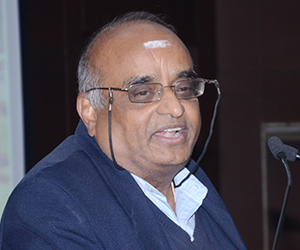Memo to FM: An education bank, easy loans to India Uninc, tax breaks for savers – and my dog
Since it is customary to give unsolicited advice to the finance minister in the run-up to the budget, here are some. In order to make it easy for the finance minister to quickly get the gist, the suggestions are short, and, in most cases, the operative details are in bullet points.
92 percent of our investment has come from domestic savings…
These are given last year also—but in India it does not matter since Finance Ministers are too busy about FII and Financial markets even to read our suggestions. So I give the same things again with many additions.
Setting up an education finance bank:
- We need a specialised Education Finance Bank, similar to HDFC in housing, which can also raise deposits.
- The initial capital of Rs 5,000-10,000 crore can be provided by various finance institutions
- All education/ skill formation courses can be financed by this bank. It can be tailored to finance course from MBAs to ITIs and even schooling.
- Loans can be only for domestic education
- Interest earned by depositors in this bank can be exempt from taxes to augment resources
- All certificates issued for courses completed with bank loans will reflect the EMI payable
- Employers should, by law, be asked to deduct EMIs like TDS and remit to the bank. This will minimise NPAs which are high in education loans today
- Without Educational Finance at all levels the whole skilling /make in India initiative will not take off
New financial architecture for the non-corporate sector
- The share of the non-corporate sector in GDP is nearly 50 percent (Agriculture 18 percent, government 18 percent, and corporate sector 14-15 percent; See My book India Uninc, published by Tata Westland)
- The finance minister should focus on the non-corporate 50 percent rather than the pink paper-obsessed 15 percent called the “organised” corporate sector
- The service sector, comprising activities like construction, trade, hotels and restaurants, transport, professional business services, etc., constitutes nearly 67 percent of our economy. These are also the fastest-growing sectors, with more than 8-9 percent compounded annual growth over the last decade.
- The non-corporate sector, consisting of partnership and proprietorship firms, is dominant (more than 70 percent) in service sector activities
- The share of bank financing has come down from around 58 percent in 1990 to 36 percent in 2011 to this sector.
- The 42 million non-farming enterprises are owned to the extent of 51 percent by OBCs (38 percent), STs (4 percent), and SCs (9 percent). OBC ownership is more than the proportionate share of the OBC population. This is the foundation of entrepreneurship in India. If India is an entrepreneur-led economy unlike China, it is because of this sector. The credit supply to this critical sector from organised financing institutions is below 10 percent (Economic Census 2005). This sector is fleeced by local money lenders. Here is one way to solve this funding challenge.
- We need a separate financial architecture for this sector – free from rigid banking rules and flexible on lending practices. The institution should be free to raise cheap resources with safeguards for depositors and investors. Only a non-banking financial company can reach this sector. A committee of the finance ministry, the ministry of small and medium enterprises, ministry of rural development, and the Reserve Bank may be appointed to frame rules for this new financial architecture free from Basel-based banking norms.
- Mudra initiative as of now is under SIDBI—A new law need to be formed to take it forward outside RBI framework.
FII/FDI role
- FII and FDI investments put together have never exceeded 8 percent of our domestic investment
- 92 percent of our investment has come from domestic savings
- Household savings (including proprietorship/partnership firms) has been nearly 75 percent of our domestic savings
- Hence give tax incentive for domestic savers
- The finance minister should thus say no to arm-twisting by FIIs and foreign investors. Globally, funds are in search of markets – nearly $18 trillion of pension funds is looking for good investing avenues. We should thus allow FDI while leveraging our political advantage – like China
- The FM should also say no to reversing retrospective taxes since this has been done by many European countries, including UK. Indian asset transfers should be taxed by India. Period
Enhancing domestic savings
- Since domestic savings constitute more than 90 percent of our investments, there is a need to increase the tax-exempt savings limit (80C, including public provident fund) to Rs 5 lakh from the current Rs 1 lakh.
- The income-tax exemption limit should be raised to Rs 10 lakh for individuals and Rs 20 lakh ($29,000) for HUFs to distinguish between individual salary earners and partnership/proprietorship firms
- Interest earned on deposits with the Education bank should be exempt from taxes
Give my dog a break
Animal lovers spend on veterinary doctors/medicines. This cost is not recognized anywhere.
- Individuals get tax deductions up to Rs 15,000 ($220) for medical and drug expenses
- For domesticated animals like dogs/ cats, one can consider expenses of up to Rs.10,000 per annum ($145) per animal. This will get thank you votes from animal lovers.
Dividend tax
- As of now dividends are not taxed at all in the hands of receivers
- There are many individuals earning Rs 500-600 crore a year and still not paying taxes. Many of them could be promoters of companies or high-earning employees who have large shareholdings due to Esops.
- Technical arguments are given about double taxation of income to “justify” this zero tax, but it is morally unacceptable that the rich should pay zero tax. Dividend incomes above a certain minimum level should be taxed at the marginal rate of 30 percent.
- Many Emerged countries do have Dividend Tax in the hands of Shareholders
Scrap FCRA
Significant amounts of money flow into the country through the Foreign Contributions (Regulation) Act (FCRA). In the last fifteen years, more than Rs 100,000 crore ($14.7 billion) has come in for the NGO sector from global patrons. Of the 40,000-and-odd NGOs registered under FCRA, at least half of them do not file proper accounts with the ministry. Some of them are religious organisations. With the enactment of compulsory spends on corporate social responsibility (CSR) under the new Companies Act, the time has come to scrap FCRA and ask the NGOs to seek local funds.
Domestic black money
- The Supreme Court-constituted SIT is looking into illicit money kept abroad
- For domestic black money, the following steps can be considered: withdrawal of notes in Rs.500 and Rs.1,000 denominations over a period of one year;
- Bring in a law to make holdings of cash beyond Rs 10 lakh (or a more relevant figure) as a crime. This needs amendments to the Coinage Act, FEMA, RBI Act, etc. This step was suggested in a recent report on steps to curb black money. Currently, if you have excess cash holdings, the tax department has to prove that the holdings are disproportionate to known sources.
Enhancing Resources
There are many low-hanging fruit available to the finance minister in the budget. This could add up to nearly Rs 1,00,000 crore of non-tax revenue. The extra resources can come from selling the shares of many public companies including banks and also shutting down many Govt activities like I&B ministry etc.
Database of the tax system
We need to revive the All India Income Tax Statistics (AIITS), a publication which used to offer a wealth of data on taxes paid, exemptions given, etc., category-wise (i.e. companies, HUFs, partnerships). It also used to give sector-wise details – retail trade/chemists/doctors/lawyers, and so on. Its publication has been stopped since 2001. Some of this information is now available only in the diaries of tax officials. If transparency is the best disinfectant in finance, its publication should be resumed.
Release of the black money report
A report by three Delhi-based institutions regarding black money has been submitted to the finance ministry. These reports can be released to the public for wider dissemination. There is no need to treat this as a state secret, since these are academic reports, and don’t pertain to Swiss bank data.
Financial commission to monitor all inward funds
India gets funds from varied sources – some known, some unknown. Not all FII/ FDI/ FCRA, export remittances and hawala deals can be traced. The government should constitute a financial commission to monitor all inward remittances of funds and evolve appropriate measures if they are suspicious in nature.
The author is Professor of Finance at IIM Bangalore. The views are personal
Published in http://rvaidya2000.com on 30th January 2016. Image Source: http://www.dnaindia.com
(Disclaimer: The views and opinions expressed in this article are those of the author and do not necessarily reflect the official policy or position of the Vivekananda International Foundation)









Post new comment